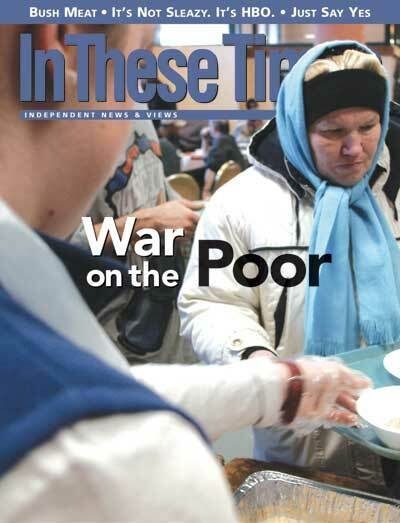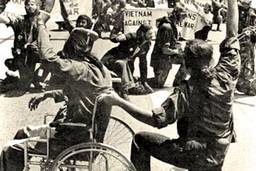
You’d think Maureen Lane would be happier than this. In April, after years of lobbying by her Welfare Rights Initiative and a coalition of advocates for the poor, the New York City Council passed Local Law 23, the Coalition for Access to Training and Education law. Seven years after President Clinton authorized strict limits on education for welfare recipients, the CATE law would at last allow city residents to enroll in college classes without jeopardizing their welfare benefits. The euphoria lasted all of one month.
On May 8, New York Mayor Michael Bloomberg filed suit against the council, saying it was his prerogative to decide how to run the city’s welfare programs, and no two-bit gang of elected officials was going to tell him how to do it. Two months later, Bloomberg’s Human Resources Administration upped the ante, announcing that it would refuse to comply with the law, prompting a legal showdown that could drag on for years.
And now, as the latest wave of welfare legislation slogs through Congress, the entire CATE law could be wiped out by new federal requirements that would force cities and states to pull welfare recipients out of classes and find them jobs—any jobs, no matter if they’d be enough to pay the rent, let alone lift families out of poverty. So instead of spreading the word on the opportunities provided by Local Law 23, the CATE Coalition is back to lobbying local officials to do what they thought had been achieved back in April.
“In the City University of New York system alone, we’ve lost 23,000 students” to the changes in welfare law, Lane says. “That we even have to add one more family to that statistic this year, that’s the shame of it.”
As hopes for a more progressive, less punitive welfare reform have fallen away before the reality of a Republican-controlled Congress, education was thought to be the one possible exception. Unlike such wild-eyed schemes as guaranteed childcare or lifting the five-year time limit on benefits, education and training programs appeal even to many Republicans: Sen. Olympia Snowe (R-Maine) long has championed her state’s Parents as Scholars program, which lets students count classroom time toward welfare’s work requirements.
Certainly, there’s plenty of evidence that education is by far the most effective and lasting route out of poverty. Studies have shown that a GED or high school diploma can boost earnings by more than 30 percent; with a vocational or bachelor’s degree, income nearly doubles. Maine’s Parents as Scholars program is a case in point: Its graduates’ earnings jumped from $7.50 to $11.71 an hour after getting a college degree.
Traditionally, earning an education while receiving welfare was a common route out of poverty. All that changed in 1996, when the new Temporary Assistance to Needy Families program imposed a one-year cap on schooling, requiring at least 20 hours of work a week on top of coursework. Immediately, says Lane, enrollment of welfare recipients at CUNY plummeted.
“Students would say, ‘I can’t take this workfare assignment, it’s right in the middle of my class schedule, and I’m about to graduate,’” she recalls. “You’re told you’re going to lose your food stamps and your Medicaid and everything else unless you forget school—the students left in droves.”
For the architects of welfare reform, it wasn’t a moment too soon. In an August 5 Washington Post op-ed, Heritage Foundation welfare guru Robert Rector and his colleague Brian Riedl blasted schooling as a waste of time: “Welfare recipients assigned to immediate work see their earnings increase more than twice as fast over the following five years as those first placed in education-based programs, according to calculations we made using data from the Manpower Demonstration Research Corp. If the goal of welfare reform is to raise earnings while reducing dependency, then quickly moving welfare recipients into real jobs is the answer. Prolonged classroom training tends to be the dead end.”
Not so, says Mark Greenberg of the D.C.-based Center for Law and Social Policy. The study in question, he explains, found that narrow job-search programs fared slightly better at boosting short-term income than those stressing adult basic education—but never studied the effects of GED or vocational training, let alone a college degree.
“It makes sense that if somebody is at a 5th-grade reading level and can get to a 6th- or 7th-grade reading level, it doesn’t much affect employment prospects,” Greenberg says. In fact, the program most effective at increasing earnings was a Portland, Oregon, program that included both job-search and vocational training. (The MDRC study also found that none of the programs significantly boosted total income. Participants’ paychecks were neatly matched by loss of food stamps and welfare benefits, leaving them just as poor as when they started.)
For welfare activists and recipients themselves, the value of education is self-evident.
“I was going to school for my GED, and I was only allowed to go two days a week,” says Nichole Thomas, a mother of two who recently joined Families United for Racial and Economic Equality, one of the groups in New York’s CATE Coalition. “Welfare is supposed to be a stepping stone to help you get on your feet. If they make you drop out of college, how are you going to get on your feet? We would rather have a job. But if you’re going to end up working at McDonald’s, it’s not enough.”
Theresa Bill, then a women’s studies lecturer at the University of Hawaii, says that when the new work rules came down, “people were leaving school in droves. Talking to students about their classroom performance, it was clear that with their work hours they just didn’t have time to do their homework.”
To stem the tide of dropouts, the university teamed with the state department of human services to create Bridge to Hope, which allows students receiving welfare to count class time toward their work requirements, and provides part-time campus jobs to cover the rest. It’s been a popular program, with the 150 students it serves annually and with state legislators.
If trying to get an education while on welfare is a mess now, it could be thrown into complete disarray when Congress finally passes legislation reauthorizing TANF, which could happen anytime in the next few months.
While welfare terminology gets more arcane with each new “reform,” two of the key battlegrounds in the current reauthorization debate are over work hours and participation rate. Under existing law, recipients must work (or participate in “work activities”) 30 hours a week, although some states have passed even stiffer standards. House Republicans, following the lead of the Bush administration, have called for a 40-hour-a-week workload, with a minimum of 24 hours in “core activities” precluding training or community service—a schedule that would effectively block single moms from taking classes without risking their benefits.
The participation rate is a more esoteric figure, indicating the minimum number of welfare recipients who must meet program rules for a state to continue receiving federal funds. Under the 1996 law, the rate stands at 50 percent—but “caseload reduction credits” for cutting the rolls have given some states effective participation rates as low as zero. (Only five states, according to the Department of Health and Human Services, have half their caseloads officially participating in TANF.)
“Under current law, a state is always free to let somebody participate in postsecondary education, but if it’s for more than 12 months, it can’t count toward the participation rate,” Greenberg says. “Once you’ve got a high participation rate, you really have to structure your program around what does or doesn’t count.”
Both the House and Senate bills would raise this bar to 70 percent, with much less wiggle room than under the old law: The House would credit only caseload reduction since 2001, while the Senate bill would provide a limited “employment credit” for moving people off welfare into jobs. For states that have been using the old law’s leeway to ease restrictions on education—23 states, according to CLASP, currently allow more access to education than is permitted under TANF—such a jump in the rate would be a catastrophe. (New York’s CATE law, in fact, would likely be nullified entirely, as it requires the state to exceed the minimum participation rate by at least 10 percent—an easy target now, but nearly impossible under a strict 70 percent rate.)
Taken together, the increased work hours and tightened participation rates are expected to hit states with billions of dollars in new program costs, at a time when state governments swimming in red ink are already looking to slash benefits. It’s a scenario that could severely blunt the impact of Sen. Snowe’s Parents as Scholars amendment—attached to the Senate bill, but not the House—which would let states allow college classes to count toward work hours. Even if the Snowe amendment survives, there’s the danger that cash-strapped states will simply decline to implement a program that would force them to keep paying benefits to students until they get a degree.
“With the unemployment rate what it is, there is no way to put everybody to work, so the states are going to have to create massive workfare programs,” says Berkeley education activist Diana Spatz, noting that the California legislative analyst’s office estimated $2.9 billion in new costs if the House bill passes. “I don’t know how our state’s going to be able to manage.”
Until the Congressional debates are settled, Spatz and other activists can only continue their local efforts, hoping that they aren’t obliterated by the latest dictates from Capitol Hill. For New York’s CATE Coalition, it means everything from staging meetings with local education officials, to ambushing city welfare chief Verna Eggleston—who downplayed her single-mother’s reliance on welfare for nearly two decades—outside her office to demand a meeting on the still-dormant Local Law 23.
Nichole Thomas, one of those who confronted Eggleston, says there’s no excuse for the current stalemate: “If there are people out there who don’t mind working, that’s fine. But there’re a lot of us who do need a diploma. You got yours. Why can’t we get it?”
On May 8, New York Mayor Michael Bloomberg filed suit against the council, saying it was his prerogative to decide how to run the city’s welfare programs, and no two-bit gang of elected officials was going to tell him how to do it. Two months later, Bloomberg’s Human Resources Administration upped the ante, announcing that it would refuse to comply with the law, prompting a legal showdown that could drag on for years.
And now, as the latest wave of welfare legislation slogs through Congress, the entire CATE law could be wiped out by new federal requirements that would force cities and states to pull welfare recipients out of classes and find them jobs—any jobs, no matter if they’d be enough to pay the rent, let alone lift families out of poverty. So instead of spreading the word on the opportunities provided by Local Law 23, the CATE Coalition is back to lobbying local officials to do what they thought had been achieved back in April.
“In the City University of New York system alone, we’ve lost 23,000 students” to the changes in welfare law, Lane says. “That we even have to add one more family to that statistic this year, that’s the shame of it.”
As hopes for a more progressive, less punitive welfare reform have fallen away before the reality of a Republican-controlled Congress, education was thought to be the one possible exception. Unlike such wild-eyed schemes as guaranteed childcare or lifting the five-year time limit on benefits, education and training programs appeal even to many Republicans: Sen. Olympia Snowe (R-Maine) long has championed her state’s Parents as Scholars program, which lets students count classroom time toward welfare’s work requirements.
Certainly, there’s plenty of evidence that education is by far the most effective and lasting route out of poverty. Studies have shown that a GED or high school diploma can boost earnings by more than 30 percent; with a vocational or bachelor’s degree, income nearly doubles. Maine’s Parents as Scholars program is a case in point: Its graduates’ earnings jumped from $7.50 to $11.71 an hour after getting a college degree.
Traditionally, earning an education while receiving welfare was a common route out of poverty. All that changed in 1996, when the new Temporary Assistance to Needy Families program imposed a one-year cap on schooling, requiring at least 20 hours of work a week on top of coursework. Immediately, says Lane, enrollment of welfare recipients at CUNY plummeted.
“Students would say, ‘I can’t take this workfare assignment, it’s right in the middle of my class schedule, and I’m about to graduate,’” she recalls. “You’re told you’re going to lose your food stamps and your Medicaid and everything else unless you forget school—the students left in droves.”
For the architects of welfare reform, it wasn’t a moment too soon. In an August 5 Washington Post op-ed, Heritage Foundation welfare guru Robert Rector and his colleague Brian Riedl blasted schooling as a waste of time: “Welfare recipients assigned to immediate work see their earnings increase more than twice as fast over the following five years as those first placed in education-based programs, according to calculations we made using data from the Manpower Demonstration Research Corp. If the goal of welfare reform is to raise earnings while reducing dependency, then quickly moving welfare recipients into real jobs is the answer. Prolonged classroom training tends to be the dead end.”
Not so, says Mark Greenberg of the D.C.-based Center for Law and Social Policy. The study in question, he explains, found that narrow job-search programs fared slightly better at boosting short-term income than those stressing adult basic education—but never studied the effects of GED or vocational training, let alone a college degree.
“It makes sense that if somebody is at a 5th-grade reading level and can get to a 6th- or 7th-grade reading level, it doesn’t much affect employment prospects,” Greenberg says. In fact, the program most effective at increasing earnings was a Portland, Oregon, program that included both job-search and vocational training. (The MDRC study also found that none of the programs significantly boosted total income. Participants’ paychecks were neatly matched by loss of food stamps and welfare benefits, leaving them just as poor as when they started.)
For welfare activists and recipients themselves, the value of education is self-evident.
“I was going to school for my GED, and I was only allowed to go two days a week,” says Nichole Thomas, a mother of two who recently joined Families United for Racial and Economic Equality, one of the groups in New York’s CATE Coalition. “Welfare is supposed to be a stepping stone to help you get on your feet. If they make you drop out of college, how are you going to get on your feet? We would rather have a job. But if you’re going to end up working at McDonald’s, it’s not enough.”
Theresa Bill, then a women’s studies lecturer at the University of Hawaii, says that when the new work rules came down, “people were leaving school in droves. Talking to students about their classroom performance, it was clear that with their work hours they just didn’t have time to do their homework.”
To stem the tide of dropouts, the university teamed with the state department of human services to create Bridge to Hope, which allows students receiving welfare to count class time toward their work requirements, and provides part-time campus jobs to cover the rest. It’s been a popular program, with the 150 students it serves annually and with state legislators.
If trying to get an education while on welfare is a mess now, it could be thrown into complete disarray when Congress finally passes legislation reauthorizing TANF, which could happen anytime in the next few months.
While welfare terminology gets more arcane with each new “reform,” two of the key battlegrounds in the current reauthorization debate are over work hours and participation rate. Under existing law, recipients must work (or participate in “work activities”) 30 hours a week, although some states have passed even stiffer standards. House Republicans, following the lead of the Bush administration, have called for a 40-hour-a-week workload, with a minimum of 24 hours in “core activities” precluding training or community service—a schedule that would effectively block single moms from taking classes without risking their benefits.
The participation rate is a more esoteric figure, indicating the minimum number of welfare recipients who must meet program rules for a state to continue receiving federal funds. Under the 1996 law, the rate stands at 50 percent—but “caseload reduction credits” for cutting the rolls have given some states effective participation rates as low as zero. (Only five states, according to the Department of Health and Human Services, have half their caseloads officially participating in TANF.)
“Under current law, a state is always free to let somebody participate in postsecondary education, but if it’s for more than 12 months, it can’t count toward the participation rate,” Greenberg says. “Once you’ve got a high participation rate, you really have to structure your program around what does or doesn’t count.”
Both the House and Senate bills would raise this bar to 70 percent, with much less wiggle room than under the old law: The House would credit only caseload reduction since 2001, while the Senate bill would provide a limited “employment credit” for moving people off welfare into jobs. For states that have been using the old law’s leeway to ease restrictions on education—23 states, according to CLASP, currently allow more access to education than is permitted under TANF—such a jump in the rate would be a catastrophe. (New York’s CATE law, in fact, would likely be nullified entirely, as it requires the state to exceed the minimum participation rate by at least 10 percent—an easy target now, but nearly impossible under a strict 70 percent rate.)
Taken together, the increased work hours and tightened participation rates are expected to hit states with billions of dollars in new program costs, at a time when state governments swimming in red ink are already looking to slash benefits. It’s a scenario that could severely blunt the impact of Sen. Snowe’s Parents as Scholars amendment—attached to the Senate bill, but not the House—which would let states allow college classes to count toward work hours. Even if the Snowe amendment survives, there’s the danger that cash-strapped states will simply decline to implement a program that would force them to keep paying benefits to students until they get a degree.
“With the unemployment rate what it is, there is no way to put everybody to work, so the states are going to have to create massive workfare programs,” says Berkeley education activist Diana Spatz, noting that the California legislative analyst’s office estimated $2.9 billion in new costs if the House bill passes. “I don’t know how our state’s going to be able to manage.”
Until the Congressional debates are settled, Spatz and other activists can only continue their local efforts, hoping that they aren’t obliterated by the latest dictates from Capitol Hill. For New York’s CATE Coalition, it means everything from staging meetings with local education officials, to ambushing city welfare chief Verna Eggleston—who downplayed her single-mother’s reliance on welfare for nearly two decades—outside her office to demand a meeting on the still-dormant Local Law 23.
Nichole Thomas, one of those who confronted Eggleston, says there’s no excuse for the current stalemate: “If there are people out there who don’t mind working, that’s fine. But there’re a lot of us who do need a diploma. You got yours. Why can’t we get it?”
SPECIAL DEAL: Subscribe to our award-winning print magazine, a publication Bernie Sanders calls "unapologetically on the side of social and economic justice," for just $1 an issue! That means you'll get 10 issues a year for $9.95.
Neil deMause is a regular contributor to In These Times, and the editor of heremagazine.com. His article “Bad to Worse: Welfare Reform Is Up for Reauthorization, But It’s Only Going to Get Meaner” (ITT, Sept. 2, 2002) was selected by Project Censored as one of its Top 25 Censored Media Stories of 2002-03.






